St Petersburg Travel Guide
Situated on the Gulf of Finland and spread over numerous islands in the Neva Delta, St Petersburg is known as the 'Venice of the North'. It's a city of arched bridges, winding canals and wide boulevards, coupled with elegant palaces, impressive squares and ornate churches. It has an elegance reminiscent of cities like Paris, Berlin and Amsterdam, but is at the same time uniquely Russian, beguiling with a charm all its own.
Founded by Peter the Great in 1703, it's the country's most beloved and beautiful city. It became the capital of Tsarist Russia, and the greatest artists, sculptors and architects worked together to create the city's elegant look. Rich palaces and government buildings line the streets, along with majestic cathedrals and elaborate churches, such as the golden spires of St Peter and Paul's Cathedral, the magnificent gleaming dome and grand colonnaded facade of St Isaac's, and the colourful multi-domed Church of the Resurrection.
Although the Russian capital moved to Moscow after the Revolution, St Petersburg remains the principal artistic and cultural centre of the country. It is the birthplace of Russian ballet and performances by the Kirov Ballet, which rivals the Bolshoi ballet in Moscow, are shown in the historic Mariinsky Theatre. The magnificent green and white Winter Palace forms part of the Hermitage Museum, one of the world's greatest art galleries and the city's foremost attraction.
With its romantic waterways and decorative Tsarist architecture, St Petersburg is also the perfect setting for the famous 'White Nights', and the summer months of June and July are crowded with visitors who come to experience the dreamy twilight that takes the place of night.
Things to do in St Petersburg
St Petersburg is filled with a wealth of beautiful buildings and churches, many of them along one of Russia's most famous streets, Nevsky Prospekt. Nevsky Prospekt is a wide and sweeping boulevard running through the centre of the city all along the Neva River. The Admiralty, the Alexandr Nevsky Monastery where many famous Russians are buried, the wide Griboeva Canal, Kazan Cathedral, and the Church of Our Saviour on the Spilled Blood are all located along Nevsky Prospekt. While based on the more famous St Basil's Cathedral in Moscow, many consider the Church of Our Saviour on the Spilled Blood to be the more interesting example of Russian folk-inspired architecture.
St Petersburg's most famous attraction is probably the Winter Palace and the Hermitage Museum, located on Palace Square. This massive green, white and gold Russian Baroque palace houses one of the world's greatest museum collections, ranging from ancient Russian historical artefacts to modern European art, with the sumptuously decorated rooms an exhibition in themselves. The museum is far too big to explore in one visit, so it's a good idea to choose a section when visiting.
The Peter and Paul Fortress houses old jails and dungeons open to tourists, as well as several historical museums, the country's Mint, and the Cathedral of St Paul and St Peter where every Russian emperor since Peter the Great is buried. St Isaac's is another famous church worth visiting, both for its impressive Russian Classic architecture and the climb to the top of the church's dome for panoramic views of the city.
Travellers planning a lot of sightseeing in St Petersburg should consider purchasing the Petersburg Card which allows free entry to certain attractions and lots of other discounts and specials.
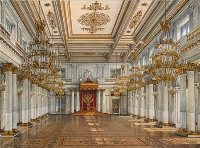
The Winter Palace and the Hermitage Museum
At 656 foot-long (200m), the Winter Palace is the biggest and most lavishly decorated in the city. Once the official residence of the tsars, Catherine the Great added the Small and Large Hermitages as a sanctuary for herself and her private art collection. The Hermitage Museum comprises a stately complex of buildings strung along the embankment, with the Winter Palace at its heart. Its collection has grown to contain more than three million pieces, its three floors covering from ancient times and modern art to works by the Impressionists and Post-Impressionists. A rich interior is bedecked with elaborate mosaics, alongside white marble staircases, golden ceilings and crystal chandeliers.
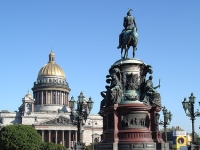
Palace Square
Palace Square contains the picturesque Baroque buildings of the Winter Palace and Hermitage Museum, while standing opposite are the Classical yellow and white former General Staff buildings of the Russian army. The focal point is the Alexander Column, a tall monolith of red granite topped by the statue of an angel and a cross. Palace Square has been the site of numerous political protests, most notably the demonstrations of Bloody Sunday in 1905 that sparked the Russian Revolution. Today, the square is filled with markets and outdoor cafes, offering beautiful views of the Admiralty's golden spire and the dome of St Isaac's Cathedral across the vast stone paving.
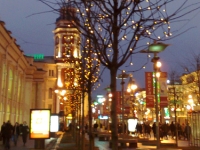
Nevsky Prospekt
Almost three miles (5km) long, Nevsky Prospekt is one of the best-known streets in Russia and the main thoroughfare of St Petersburg. It starts at the gilded spire of the Admiralty Building, passing both the Moscow Railway Station and the Alexander Nevsky Monastery. The hub of St Petersburg for centuries, it cuts through the most important segment of the city. Intersected by rivers and canals, the most beautiful part of the avenue surrounds the Griboyedov Canal. The grand Kazan Cathedral catches the eye, as does the breathtaking onion domes of the Church of Our Saviour on the Spilled Blood. Modelled on St Basil's in Moscow it's adorned with exquisite mosaic panels. Aside from the many places of worship, the street also boasts St Petersburg's finest shops and restaurants.
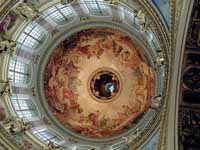
St Isaac's Cathedral
The golden dome of St Isaac's Cathedral dominates the skyline of St Petersburg, with the colonnade around the cupola offering superb panoramic views over the city. Commissioned by Tsar Alexander I to be a magnificent imperial cathedral, the ensuing masterpiece was of grandiose proportions which took more than 40 years to build. It was decorated in the most extravagant manner, incorporating many different kinds of stone and marble work. The Russian Classic exterior encloses a splendid interior adorned with red granite columns, exquisite mosaics and painted ceilings, along with sculptures, frescoes and a beautiful stained-glass window. The cathedral can accommodate 14,000 worshippers, and no photography or filming is allowed.
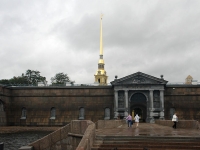
Peter and Paul Fortress
Situated on a small island across the river from the Hermitage Museum, the Peter and Paul Fortress is the oldest surviving building in St Petersburg. Planned as a defence against possible attacks from Sweden, the six corner bastions were turned into cells for political prisoners such as Leon Trotsky and Maxim Gorky. Other buildings in the fortress house the City History Museum and the Mint. Also enclosed within the imposing walls is the Cathedral of St Peter and St Paul, its distinctive golden needle-like spire visible throughout the city. The first church in the city to be built from stone, it has a richly decorated interior containing the tombs of every Russian Emperor since Peter the Great.
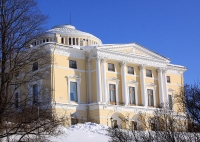
Pavlovsk Palace
Lying about 19 miles (31km) outside St Petersburg, the Pavlovsk Palace is somewhat more restrained than its surrounding contemporaries. Built in 1780 by the future emperor Paul I and designed by a Scottish architect, it included landscaped gardens in the British style. Turned into a museum following the Russian Revolution, it was nearly destroyed in the Second World War. But thankfully, its old furnishings and artwork have been tracked down and beautifully restored. Today, the palace displays rooms exactly as they were when occupied by the Russian royalty. The extensive grounds are also beautifully kept and are available to visitors for strolling and picnicking.
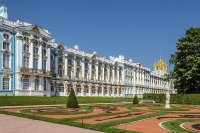
Tsarskoe Selo
Tsarskoe Selo is a former Romanov summer residence located about 15 miles (25km) outside of St Petersburg. Originally a gift from Peter the Great to his wife, it was developed by different emperors and empresses through the ensuing years. The Baroque Catherine Palace and the neoclassical Alexander Palace are the main buildings on the estate, the former houses the famous Amber Room panelled entirely with pieces of amber and filled with amber artwork. The palace grounds are extensive and contain many surprising small buildings, such as the Chinese Village and the Cameron Gallery, housing varied temporary exhibitions. It's an extremely popular spot in the summer months so it's a good idea to arrive early.
Getting Around
Locals in St Petersburg make good use of their public transport, which is extensive if not efficient and reliable. There are multiple tramlines, close to 200 bus routes and numerous trolley buses, but no night service is available after midnight. All these are overcrowded, irregular and often break down. Bus, tram and trolley bus tickets can be bought from kiosks or the drivers and are validated on boarding.
Tram and trolley stops are marked with a 'T' sign hanging from the overhead wires. A popular form of local transport, more efficient than the buses, are passenger vans called marshrutka which follow the same routes as buses and trams, and stop on request. St Petersburg's metro has five lines and 67 stations and is extremely efficient and easy to use, even though signs are not in English. Tokens and multi-journey cards can be obtained at booths on the stations and are valid for as long as you are inside the system.
Taxis are clearly marked and can be hailed in the street or by telephone. Passengers should check that the meter is working or negotiate before departing. Most private car drivers in the city will act as a taxi and offer you a ride, but be sure to settle the price before accepting. Self-driving is difficult due to the thick traffic and bad road surfaces and the fact that road signs are in Cyrillic. Far easier is hiring a car with a driver, the preferred option offered by the main car rental companies.
St Petersburg Climate and Weather
St Petersburg's climate is mild, though unpredictable. Winters are cold (November to March), with freezing winds and snowfall, and temperatures that average between 16°F (-9°C) and 26°F (-3°C). Temperatures sometimes drop lower in January and February, which are the coldest months. June to August is usually the warmest time of year, though temperatures are still relatively low and average in the mid-60s Fahrenheit (about 20°C) at most. Summer tends to be the most popular time to travel to St Petersburg.
Russia travel info
Electricity
Electrical current is 220 volts, 50Hz. Round two-pin plugs are standard.
Language
Russian is the official language. Some people speak English, French or German.
Money
The official currency is the Rouble (RUB), which is divided into 100 kopeks. Most major international credit cards are accepted in larger establishments. Currency can be changed at banks, bureaux de change and hotels, with ATMs widely available in major cities. It's hard to get roubles outside Russia and travellers are advised to take currency in good condition to exchange once there.
Tipping
Hotel bills in the large Russian cities usually include a 10 to 15 percent service charge. If no service charge has been added, a tip of at least 10 percent is expected. City Guides and their drivers also expect a small tip and tipping in bars and nightclubs is common.
Health
Drinking water should be treated, with bottled water readily available. Local state medical facilities in cities outside the main urban hubs are of a low standard, and visitors are strongly advised to have full insurance for medical treatment and accidents should they require private care. Blood transfusions should not be performed in Russia, due to uncertainties concerning the blood supply. Essential medications and supplies may be limited.
Safety
Though Russia is generally a safe country in which to travel, visitors should be vigilant and watch out for pickpockets, particularly on the metro and buses. Moreover, travellers must insist on seeing official identification from police officers. Political protests often end in violence and visitors are advised to avoid all street demonstrations and political gatherings.
Local customs
Photography of anything to do with the military, strategic sites or the airport is prohibited. In Russian Orthodox churches, women are advised to wear skirts and cover their heads with a scarf. It's a legal requirement for visitors to carry passports for identification, with copies not being sufficient. Russia has a poor LGBT rights record, and same-sex couples should exercise caution.
Doing business
Business in Russia is conducted in a fashion similar to Western countries, but with some subtle differences. Russians are business-minded so it's not generally necessary to form personal relations with business colleagues, but developing a good network of resident associates is a good idea.
Dress is formal and conservative and on greeting a good firm handshake and direct eye contact indicates strength. Business cards are exchanged and it's advisable to print a Cyrillic translation of your details on the alternate side. Business hours are generally from 9am to 6pm, Monday to Friday.
Duty free
The following may be imported into Russia without customs duty: 200 cigarettes, 100 cigarillos, 50 cigars or 250g of tobacco products (over 18 years), 2 litres of alcohol (over 21 years), perfume for personal use, gifts up to the value of US$10,000. Tourists must complete a customs declaration form, to be retained until departure, allowing for the import of articles intended for personal use (including currency and valuables) which must be registered on the declaration form.
Additionally, 250g of caviar per person may be exported, with a receipt proving it was purchased at a store licensed to sell it to foreigners and a licence from the Ministry of Economic Development. Any items or artwork that might have historical value, like icons, maps, coins or paintings, have to be registered with the Ministry of Culture before departure, which usually involves a 100% customs duty fee.
Communications
The international access code for Russia is +7. Hotels, cafes and restaurants offering free wifi are widely available. As international roaming costs can be high, purchasing a local prepaid SIM card can be a cheaper option.
Passport & Visa
Valid visas in expired passports or other expired travel documents are not accepted. Visitors must carry ID at all times whilst in Russia. An Immigrant Card will be issued on board the aircraft or on arrival. All visitors staying for longer than seven working days must register with the Federal Migration Service upon arrival; if staying in a hotel, the hotel will arrange this, otherwise you can find the forms to fill out at a post office and post the forms to the Federal Migration Service. Anyone travelling on a tourist visa must hold vouchers from the hotel or travel agency. Passengers are required to hold return/onward tickets and documents required for the next destination. Exit permits are required on departure. These are usually issued with the visa, or can be obtained at hotels not less than two days before departure. Passports must be valid for period of intended stay. It is highly recommended that passports have at least six months validity remaining after your intended date of departure from your travel destination. Immigration officials often apply different rules to those stated by travel agents and official sources.
Entry requirements
United States citizens must have a passport valid on arrival. A visa is required.
British citizens must have a passport valid on arrival. A visa is required.
Canadian citizens must have a passport valid on arrival. A visa is required.
Australian citizens must have a passport valid on arrival. A visa is required.
South Africans must have a passport valid on arrival. No visa is required for a maximum of 90 days.
Irish nationals require a passport valid on arrival. A visa is required.
New Zealand nationals require a passport valid on arrival. A visa is required.
Useful contacts
Russian Tourism Authority: +7 495 623 7978 or www.russia-travel.com
Emergencies: 112.Embassies / consulates in other countries
Russian Embassy, Washington DC, United States: +1 202 939 8907.
Russian Embassy, London, United Kingdom: +44 20 7229 6412.
Russian Embassy, Ottawa, Canada: +1 613 235 4341.
Russian Embassy, Canberra, Australia: +61 2 6295 9033.
Russian Embassy, Pretoria, South Africa: +27 12 362 1337.
Russian Embassy, Dublin, Ireland: +353 1 492 2048.
Russian Embassy, Wellington, New Zealand: +64 4 476 6113.
Embassies / consulates in Russia
United States Embassy, Moscow: +7 495 728 5000.
British Embassy, Moscow: +7 495 956 7200.
Canadian Embassy, Moscow: +7 495 105 6000.
Australian Embassy, Moscow: +7 495 956 6070.
South African Embassy, Moscow: +7 495 540 1177.
Irish Embassy, Moscow: +7 495 937 5911.
New Zealand Embassy, Moscow: +7 495 956 3579.



